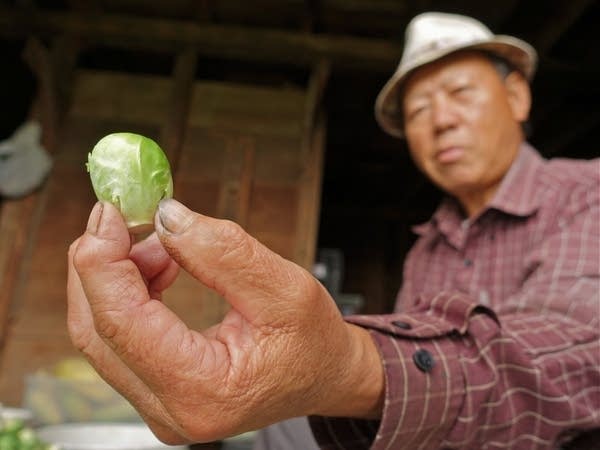'Seeds of Change' photo exhibit documents Hmong farm project

Go Deeper.
Create an account or log in to save stories.
Like this?
Thanks for liking this story! We have added it to a list of your favorite stories.
A farmer carries his 6-month-old infant on his back while he works. A young woman checks her beehives. Grandparents prepare the harvest for market.
These images are part of a photo exhibit at the Minnesota Museum of American Art in downtown St. Paul. The exhibit, "Seeds of Change," focuses on the creation of a Hmong collective farm and illustrates how the project is allowing farmers to plan — and plant — for the future.
Local filmmaker and photographer Mike Hazard, who describes himself as "a city slicker urban guy from the get-go," has been documenting the Hmong American Farmers Association, or HAFA, since it acquired a 155-acre plot of land along the Vermillion River in 2014. He said his frequent trips to the farm, and the relationships he's developed with the families, have changed his view of the food he eats.
"When I go home and I look at dinner, and I serve it, and I think 'these are Chao's Brussel sprouts,' 'this is Judy's Hmong cucumber' ... to me it adds a profound level of resonance to the experience of those beautiful foods and flowers," he said.
Turn Up Your Support
MPR News helps you turn down the noise and build shared understanding. Turn up your support for this public resource and keep trusted journalism accessible to all.
The exhibition, with its fields of flowers, blue skies and smiling faces, is infused with the optimism and pride of the farmers. Many small-scale farmers rent their land. Because they don't know whether their lease will be renewed, they are restricted to growing only those things they can harvest that same year.
Beekeeper and HAFA organizer Yao Yang said their farm was bought by an angel investor; the farmers will work the land and save up money over 10 years to buy it outright. They're willing to make improvements, knowing that the investments will pay off for years to come.

"They can actually plan ahead — they can plant perennials now. Many of our farmers, the first year, planted asparagus in the fall — planted raspberries, planted strawberries," she said. "The livelihood of the farmers market is going to change a lot, with our Hmong farmers especially."
At first, the former corn and soybean field proved challenging.
"We needed to add more lime to it, we needed to add more compost, we needed to get irrigation on the farm and we needed to build a deer fence," Yang said.
The farm is now home to more than a hundred varieties of fruits, vegetables and flowers. Looking at the pictures on the museum wall, Yang was pleased.
"It really captures the story, the narrative of our Hmong farmers," she said. "Not just our Hmong farmers, but the story of Minnesota, I think. Because we have such a rich culture and agriculture here with how committed we are to really supporting our local farmers."

Photographer Hazard said he plans to continue documenting the farmers' work in the years to come. The project has taught him a greater appreciation for the people who work to feed their communities.
Hazard remembers one farmer taking a sledgehammer to a giant rock in his field, while he and the farmer's wife looked on. The fragments looked almost metallic in the sun.
He pointed it out to the farmer's wife. "I said, 'Look, Judy! It's like gold and silver!' She said, 'Yeah, it's gold and silver.' And then she turned around and she looked at her field and she said, 'This is my gold and my silver, this field. This is my treasure.'"
"Seeds of Change: A Portrait of the Hmong American Farmers Association" runs through July 31 at the Minnesota Museum of American Art in downtown St. Paul.


